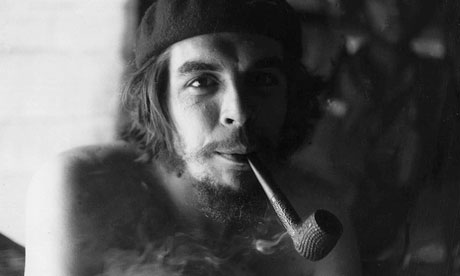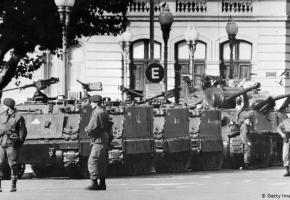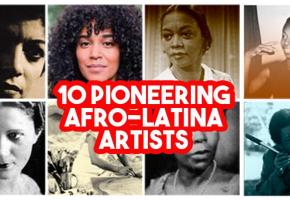
“Che had the voice of a brother”
Ciro Bustos was Che Guevara’s right-hand man in Argentina and survivor of Che’s Bolivia campaign. Once accused of betraying Che, in his new book ‘Che Wants to See You’ Ciro relates what really happened and his life beside the world’s most famous revolutionary. Latinolife talked to the painter-turned-revolutionary, now living quietly in Sweden.
by Christine Seifert
Image

Ernesto ‘Che’ Guevara is probably the world’s most famous Latin American and a global icon. For those who know only his unshaven face, framed by wavy mane and trademark beret, eyes staring into the distance, he is an omnipresent figure adorning everything from t-shirts and watches to mugs and beer. For those who know of his struggle; Che has become an enduring symbol of freedom, of the struggle for self-determination and justice, of uncompromising and unwavering ideals.
Nonetheless, until recently little was known about Che’s life post-Cuba. After leaving the island in 1965 Che joined the failed attempt to bring revolution to the Congo following the Cuban example and later departed for Bolivia. The plan was to use Bolivia as a staging post for revolution in his home country, Argentina. This would be the second attempt to set up a guerrilla base in Argentina, preparations for this mission went way back to the early years after the Cuban Revolution when a different world seemed within arm’s reach.
It is on this part of history that Ciro Bustos’ book ‘Che Wants to See You’ sheds a new light. Bustos played an integral role in these plans for the Argentine foco from their inception and his book relates, as promised, 'the untold story of Che Guevara.'
Why has Ciro waited so long to tell his story? was the first question I wanted to ask.
“For a long time, when there was so much speculation around the idea and memory of Che, I didn’t want to add to it, out of respect for him and also the many people who died trying to implement his ideals, ” says Ciro, still a fit 80-something. He is sitting in the living room of British journalist Richard Gott who was instrumental in getting the book published. “Don’t forget that for a long time, there was wide spread political repression in Latin America and many people mentioned in this story were still alive and would be in danger if their involvement in Che’s plans were known. I had to wait until the political circumstances were right in Argentina, and Latin America in general.”
After decades of silence the time has finally come to speak.
“In the end many people were urging me to tell the story, including Che’s biographer Jon Lee Anderson, who came to see. Being the only person who knows the history of both the Argentine and Bolivian guerrilla campaigns, and feeling that the memories had matured in my mind, I also sensed an obligation to tell the story.”
Ciro arrived in Cuba in 1961 shortly after the triumph of the revolution. He saw Cuba as a real alternative to the political apathy that prevailed on the continent despite huge injustices were plain to see and how American imperialism was ravaging the continent.
The trigger or “conscience call” as he perceived it, was listening to a radio interview with Che Guevara and Fidel Castro in the Sierra Maestra, by Argentine journalist Jorge Massetti, in his home town of Mendoza. “Listening to Che was like listening to a brother,” Ciro says. The effect was so powerful that the young painter headed for the Caribbean island. He took a boat from Valparaiso in Chile
On arrival in Cuba, Ciro found work helping set up a ceramics workshop and even though he encountered problems he never doubted his decision:
“I was very aware of the need for people with skills. After the revolution many Cuban professionals and technicians fled to the US. The people who stayed were very young and inexperienced. But there was great enthusiasm, shared hope and anticipation.”
Ciro described feeling an intense connection with Che on the occasions he saw him speak, always at the very front of the crowd. They exchanged eye contact, though Ciro never approached him. It was not long, however, before he was introduced to the revolutionary leader by Alberto Granado, Che’s old motorcycle travel companion, who Ciro met while giving art classes at Santiago University where Alberto was teaching medical science. Granado one day announced to Ciro, ‘El Che quiere verte’ (Che wants to see you). It was a phrase that was to be repeated by various messengers over the following years, and one that was to mark Ciro’s life in the revolutionary struggle.
Ciro describes how he arrived to meet Che for the first time at the Ministry of Industry in Havana: “It was about four o’clock in the morning, the normal time for Che’s meetings, and Che came out of his office and simply asked “You’re here?” as if we had known each other all our lives.”
From then on, Che would be “a friend, a brother, a colleague, but above all my leader.” It turned out that Ciro’s geographical knowledge of Northern Argentina was useful for Che’s plan to set up a guerrilla base in Salta and he was asked to join the group. Jorge Masetti, the journalist who had interviewed Che in the Sierra Maestra, would lead the group until they consolidated their position and Che would arrive himself.
This project was “what I had come to Cuba for,” Ciro says, “although I had never thought it possible.” He remembers that at the time, the Cuban Revolution was a huge inspiration for this group of Argentines and Latin Americans in general, being an example for the success of a small group of men in changing the political reality of a whole country. “However, the context was different in Argentina: Cuba is a small island and Argentina is a huge country – this posed some difficulties.”
The group started training in Cuba, but following the Cuban Missile Crisis, Che sent them to Algeria to complete the course. They arrived in Argentina in 1963 and founded the Ejército Guerrillero del Pueblo (EGP). Eighteen months later the group which had grown to sixty guerrillas was wiped out.
Meanwhile, Che had been fighting in the Congo. On his return, he began to organize a new guerrilla foco in the jungle of Southern Bolivia. Ciro was continuing to organize Che’s political support network when he was again summoned with the words “Che wants to see you.” This time with a ticket to Bolivia.
However, the Bolivian Army soon discovered the Che’s group and Ciro, together with the French Marxist Régis Debray, was captured as he attempted to leave the camp on Che’s orders to get support from Argentina and Europe respectively.
“We were organizing a political network in Argentina at the time, so when I was caught I had to keep in mind the needs of the group,” remembers Ciro. ”They [the Bolivian Army and the CIA] already knew Che’s whereabouts in Bolivia, so the important thing for me was to keep our operations in Argentina secret.”
Travelling on false papers, Ciro pretended to be a naïve political activist, who did not know the names of the people he had met in the camp. After two months, when the interrogators found out who Ciro really was from his fingerprints, and that he was an artist, they asked him to draw their faces. While these sketches have led Ciro to be accused of betraying his compañeros, in fact the Army and the CIA were already in possession of passport photos of everyone in the camp and Che’s face was world famous. All Ciro did was to draw bearded men in the jungle.
Che himself was shot a few months later and Ciro and Debray condemned to thirty years in prison. He was amnestied three years later after a successful coup in Bolivia by leftist general Juan José Torres. He was taken to Chile, moved to Argentina after the coup against Allende, and went into exile in Sweden during the Dirty War in Argentina. He has lived there ever since.
Ciro Bustos’ memoir offers us a unique opportunity to relive this extraordinary period of history. It is fascinating to learn about a time when young people took up arms as a means of ending exploitation and injustice, however controversial these methods might seem to some today. It has major relevance to today’s struggles.
While Latin America’s revolutionary era ended in decades of repression and disappearances, Ciro is optimistic for the future of his continent.
“Obviously my observations are taken from the distance, since I have been living in Sweden for decades,” Ciro admts. “But I see many positive changes. In the past there was a strong domination by certain classes and this dynamic has been broken to some extent, or at least fragmented.”
If there is a sign that times have changed, it is surely the venue for the launch of Ciro’s book last week. Not only did the launch take place in the Argentine Embassy, once the government that ‘disappeared ‘ anyone following Che’s ideals, Ambassador Alicia Castro hosted a dinner in honour of Che’s old friend in the presence of the Ambassador from neighbouring Ecuador.
“Not everything we hoped for has been obtained, but we are on a path where the people participate more actively, and governments are not so ready to crush their ideals.”














